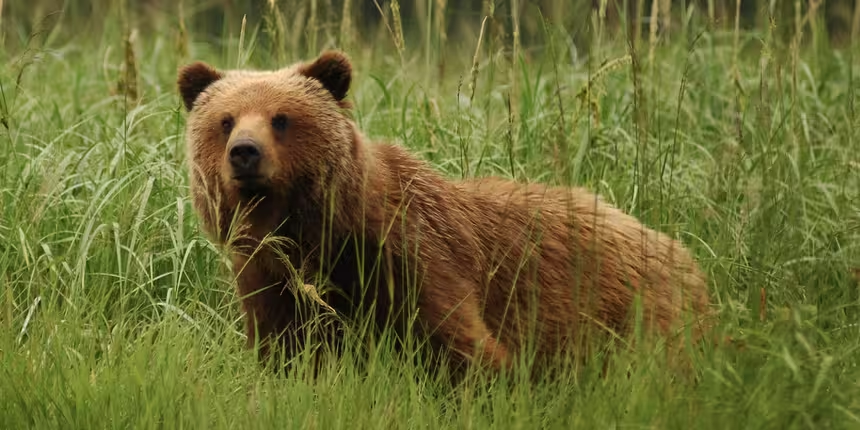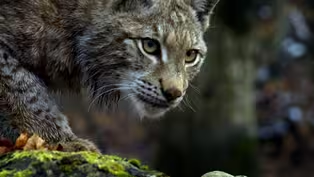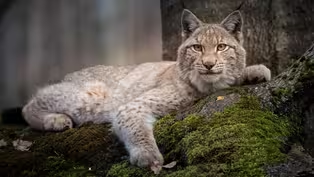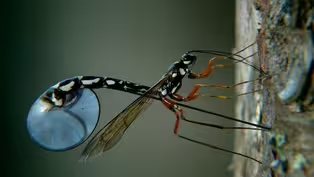
Forest of the Lynx
Season 35 Episode 15 | 52m 58sVideo has Closed Captions
Learn about plants, insects, animals and trees in the Alps' largest tract of wilderness.
Austria’s Kalkalpen National Park is the largest tract of wilderness in the Alps, but it wasn’t always that way. The park was once the site of major logging and mining operations, but those activities ceased more than two decades ago. Three years in the making, Forest of the Lynx chronicles life in this remote wilderness and the complex partnerships among plants, insects, animals and trees.
Problems playing video? | Closed Captioning Feedback
Problems playing video? | Closed Captioning Feedback
Major support for NATURE is provided by The Arnhold Family in memory of Henry and Clarisse Arnhold, Sue and Edgar Wachenheim III, The Fairweather Foundation, Charles Rosenblum, Kathy Chiao and...

Forest of the Lynx
Season 35 Episode 15 | 52m 58sVideo has Closed Captions
Austria’s Kalkalpen National Park is the largest tract of wilderness in the Alps, but it wasn’t always that way. The park was once the site of major logging and mining operations, but those activities ceased more than two decades ago. Three years in the making, Forest of the Lynx chronicles life in this remote wilderness and the complex partnerships among plants, insects, animals and trees.
Problems playing video? | Closed Captioning Feedback
How to Watch Nature
Nature is available to stream on pbs.org and the free PBS App, available on iPhone, Apple TV, Android TV, Android smartphones, Amazon Fire TV, Amazon Fire Tablet, Roku, Samsung Smart TV, and Vizio.
Buy Now

Explore More Ways to Watch
Bring the beauty and wonders of wildlife and natural history into your home with classic NATURE episodes.Providing Support for PBS.org
Learn Moreabout PBS online sponsorship♪♪ [ Creatures calling ] NARRATOR: What is it that makes a forest wild?
[ Lightning crashes ] Is it the raw forces of nature... [ Suspenseful music plays ] that do battle with the trees?
Is it all the remarkable characters that live out their lives here?
[ Chittering ] Hunting... finding mates... raising families.
Could a long-lost creature, [Sinister music plays] returning home, make it wilder still?
[ Suspenseful music plays ] [Creaking] Enter these woods, and feel the power of wild things everywhere.
♪♪ In the social life of trees... [ Birds tweeting ] in the beauty of the small... -[Squeaks] and the strange... in the return of the elusive lynx.
♪♪ ♪♪ [ Wind whipping ] Along the northern rim of the Alps, in central Austria, a forgotten forest, once heavily logged and mined, has been left to the forces of nature.
These steep gorges and hidden valleys are turning into a wild, primeval wood protected inside the Kalkalpen National Park.
[ Creatures chittering ] [ Woodpecking ] [ Insects buzzing ] Deep in the park's beech forests lives a small population of lynx, the first of their kind in 150 years.
Their story began in 1998, when a single male slipped into the park, perhaps from a population reintroduced in France or Switzerland.
His presence soon became a symbol of the return of the wild.
[ Suspenseful music plays ] [ Lightning crashes ] Extreme weather batters this rough, mountain world, night and day.
Sudden drops in temperature, storms, and heavy rains assault the trees.
Floods and landslides tear into the landscape.
[ Snap ] [ Creaking ] [ Wind whipping ] For millions of years, these natural forces powered the forest's evolution.
What looks like destruction and devastation are in fact opportunities to renew the forest, hastening its return to wilderness.
[ Creature calls, birds chirping ] [ Insects buzzing ] [ Piercing cry ] [ Piercing cry ] [ Chirping ] [ Birds joining in, chirping ] The white-backed woodpecker is the ancient forest specialist and one of Europe's rarest birds.
It spends all day hacking into old, rotting trees with its grooved beak, reducing them to woodchips; and its rasplike tongue helps it extract insects and juicy larvae.
Chiseling with extreme accuracy, it easily locates larvae.
90% of its blows strike with pinpoint precision.
♪♪ The giant wood wasp is just as precise.
A giant among wasps, almost two inches in length.
[ Whirring tune plays ] Using its drill, it penetrates deep into a dying tree and deposits its egg.
[ Rattling ] [Whimsical tune plays] [Buzz] [ Performer humming haunting tune ] The law of the forest -- "Life begins when a tree dies."
And so that millions of cubic feet of dead wood can vanish, the forest engages in one of the greatest cooperations on Earth... ♪♪ with fungi.
Fungi are a magical component of the forest, apparently appearing out of nothing.
In fact, they live almost entirely out of sight, decomposing and processing dead wood.
They only become visible when fruiting.
What we know as a mushroom exists only for reproduction... ♪♪ and is soon reabsorbed.
The honey agaric blooms only in the fall everywhere its vast networks runs.
Mycelial cords sprawl through tree trunks, providing the blossoms with nutrients.
These fragile structures are some of the largest and oldest living organisms on Earth.
[ Water babbling ] This invisible colony may weigh more than 600 tons and be 2,400 years old.
[ Insects buzzing ] [ Insects continue buzzing ] [ Bird chirps ] [ Woodpecking, squawking ] [ Suspenseful music plays ] [ Chirping, squawking ] A lynx steals silently on soft paws through the Kalkalpen National Park.
Solitary by nature, this young female, born last spring, now seeks to establish her own territory.
This will be the toughest time of her life, hunting in unfamiliar terrain while avoiding other lynxes.
[ Bird chirping ] [ Snuffles ] [ Birds chirping ] ♪♪ 'Til now, she was inseparable from her mother and siblings.
Now she is alone with her instincts.
Her survival in the wild is uncertain.
[ Chirping ] [ Peeping ] [ Grumbling ] The pygmy owl has taken up its territory.
It specializes in lightning attacks on songbirds.
[ Creature calls ] Weighing less than two ounces, it's hardly bigger than its prey.
But it's a master hunter.
[ Cheep ] [ Chirping ] [ Suspenseful music plays ] [ Cawing ] [ Chirping ] [ Suspenseful music climbs ] [ Peep-peep ] [ Sinister music plays ] [Ominous music plays] [Birds chittering] ♪♪ The forest floor starts to come alive.
More and more yellow-necked mice emerge from their winter hideout.
[ Sniffing ] These are true forest mice -- they climb trees and leap 10 times their body length with ease.
Lucky for them, because they are a delicacy for practically every forest hunter.
[ Leaves rustling ] [ Whimsical tune plays ] Mice arouse the killer instinct in any cat.
[ Creature croaks ] [ Birds chirping ] And this should be easy prey.
[ Leaves rustle ] [ Whimsical tune plays ] [ Snarls ] [ Snarling ] [ Rustling ] [ Rumble ] A lynx can hear its prey from some 150 feet away.
But yellow-necked mice do more than climb and jump.
They're experts at that ancient game of cat and mouse.
[Flute plays whimsical flourish] [ Sniffing ] [ Grumbling ] [ Creature cawing ] [ Whimsical flourish plays ] [ Birds chirping ] [Chirping] -[Squawking] [ Tweeting ] Agitated songbirds sound a warning.
The feared predator has appeared once again.
But, today, the tiny owl's intentions are quite different.
It's the mating season, and the male pygmy owl is out to impress a female.
A direct approach like that is usually rejected.
[Whimsical-romantic tune plays] So, he shows off his tree-hole.
A safe home for offspring might make a difference.
Still, she holds back.
But the prospect of a luxury home is bound to have its attractions.
[ Peeping ] At last, his persistence wins her over.
♪♪ ♪♪ [ Chirping ] [ Creature snores ] The first delicate beech leaves appear at the end of April.
The forest is in transition.
It's sunny, calm, and warm.
Perfect conditions for a mysterious creature to emerge.
[Sinister music plays] [Rusling] For a year, this female Tau Emperor moth lived as a pupa on the forest floor.
It's time for a change.
She will remain here for the next half-hour, pumping blood through new veins to unfold her wings.
♪♪ [ Ringing tune plays ] Elsewhere, highly sensitive antennae have already unfurled.
They can detect female pheromones from several hundred yards.
♪♪ They belong to a male ready to take flight.
Time is of the essence.
The lifespan of a Tau Emperor is short.
They're embarking on the most important mission of their lives -- to find a mate and reproduce.
[ Birds twittering, chirping ] [ Shimmering tune plays ] After mating, females stop producing pheromones.
But they're still wafting through the spring air, leading the males astray.
Meanwhile, the female starts laying her eggs.
[ Slurping ] [ Birds chirping ] [ Owl hoots ] The forest is now cloaked in a dense canopy of green.
Nothing grows on the ground, except where the sunlight warms the dead leaves.
[ Insects buzzing ] ♪♪ ♪♪ Trees fulfill the promise of their seeds.
Their energies are devoted to growing higher and stronger, to the point of indestructibility.
[ Birds chirping ] And yet, they do it in a socially conscious way.
They know when they have reached their natural limit, and then, they give the younger trees a chance to grow.
When a new generation germinates, the older trees take fewer nutrients from the soil and allow the saplings as much as they need.
[ Music climbs ] ♪♪ ♪♪ All these trees, silent and seemingly still, are busy foraging in the soil and reaching for the light.
[ Rustling ] And all the while, they are communicating with each other, both below and above ground.
♪♪ Yet, trees have no eyes, no ears, not even a brain, to interpret the world around them.
Exactly how they live such sophisticated lives remains a tantalizing mystery.
♪♪ ♪♪ ♪♪ In the fading light of the setting sun, the contours of the land soften.
The forest shows another face.
[ Birds chirping ] It shocks by its brightness.
Tens of thousands more stars sparkle in the night sky of the Kalkalpen than almost anywhere else, because this remote forest is one of the few truly dark places left on our planet.
♪♪ On this night, in the depths of the forest, a wonderful event has occurred -- a lynx has given birth to two kittens.
[ Screeches ] [ Screeching continuously ] [ Sibling screeches ] [ Calls ] [ Kitten whistles ] [ Whistling ] [ Whimpering ] [ Suckling ] [ Squeaking ] [ Screeches ] Her den, among the roots of an ancient beech tree, is well-protected.
The past two days have been nonstop work.
Even now, she can only leave her newborns for a brief instant.
[ Kittens whistling continuously ] At birth, the kittens are blind and depend on their mother's constant care.
[ Yowls ] [ Screeching false starts ] [ Screeching ] After a few days, they open their eyes and begin to explore their surroundings.
[ Screeching ] At this stage, they're still easily manageable.
But that won't last.
[ Twittering ] High above, in an abandoned woodpecker's tree-hole, the pygmy owls are busy with their offspring.
Both parents bring fresh prey as often as possible.
The chicks' hunger appears to be insatiable.
[Insects buzzing] [Twittering] [ Twittering ] [Twittering] -[Whines] [ Twittering ] Both parents are kept busy removing waste, too.
[ Chirping, squawking ] In the soft dawn light, it's hard to imagine that a fierce war is under way.
For over 150 years, this spruce tree has defied wind and weather, insects and disease, but the summer droughts of recent years have weakened it.
And then invaders arrive -- bark beetles.
[ Sinister music plays ] The spruce tree activates its defenses by oozing resin.
Just a few beetles attempt to penetrate the bark.
[ Ominous music plays ] ♪♪ At first, the tree has the upper hand.
But the beetles attract a whole army of their number.
Within a few hours, they arrive en masse.
The already weakened tree is unable to withstand the onslaught.
From here on in, everything happens fast.
Beetles multiply beneath the bark.
Boring through the pulp, they destroy the tree's vascular system and, with it, its ability to transport nutrients and water.
But at the start of the attack, the tree released a chemical SOS, alerting neighboring trees to the invasion.
They immediately ramped up their own production of resin to gain an advantage on the invaders.
Affected spruce trees also call on the beetles' predators.
The three-toed woodpecker is an outstanding bark-beetle hunter.
It can consume 2,000 beetles a day.
The larvae are its favorites, especially when it has -[Twittering] -hungry offspring to feed.
[ Chirps ] [ Chirps ] [ Twittering continuously ] [ Insects buzzing ] [ Scampering, squeaking ] [ Tweeting continuously ] [ Chirps ] [ Insects buzzing ] It's a prime example of the complex, delicate balance of life and death in the forest.
The greater the invasion of bark beetles, the more three-toed woodpeckers will breed here.
If the bark beetle infestation drops, the population of breeding woodpeckers will also decline.
[ Tweeting continuously ] [ Tranquil tune plays ] Even an ancient forest has its casualties.
♪♪ Water quickly seeps through brittle limestone rock.
If a summer drought goes on too long, trees dehydrate, become stressed, and weaken.
But the forest has a solution for this, too.
If it gets too dry, the trees emit molecules into the air.
These molecules have two properties -- they attract water vapor and have an adhesive quality that binds the vapor to them.
Even in the scorching heat of the sun, water remains suspended in the atmosphere.
[ Bird tweeting ] ♪♪ Out of nowhere, fog and small clouds form.
They drift across the canopy and cover the forest.
♪♪ The cooling air can no longer retain the moisture... and it begins to rain.
♪♪ ♪♪ ♪♪ [ Twittering ] During the summer months, white-backed woodpeckers spend all day hacking at rotting beech trees.
Both males and females hunt for prey, almost nonstop.
[ Chittering ] They now have a family to support.
[ Chittering ] [ Chittering ] This rare species of woodpecker has almost completely vanished from its home in the Scandinavian forests.
It only survives here in Austria because of the vast amounts of dead wood.
Without these ancient, natural forests, it is doomed to extinction.
[ Chirping ] [ Chittering ] [ Peeping ] [ Distorted tune plays ] Their sensitive antennae have brought Rosalia longicorn beetles from far away to a clearing in the middle of the forest.
♪♪ To one particular log.
The males start to duel.
♪♪ The winner has earned the right to mate.
♪♪ [ Slurping ] [ Slurping ] He was drawn here by the scent of the female.
After mating, he will die.
The female examines the damp, rotten underside of the log in search of suitable cracks.
[ Slurping ] Here, she will lay her eggs, which will develop into larvae, which, in part, will feed a new generation of woodpeckers.
[ Slurping ] [ Distorted music climbs ] [ Birds chirping ] Midsummer's approaching.
In the dense canopy of the beech trees, seeds ripen.
Beechnuts.
[ Insects buzzing ] [ Sniffing ] The young, female lynx has survived the most challenging period of her life.
She has established her own territory and learned to fend for herself.
[ Creature caws ] [ Insects buzzing ] [ Buzzing intensifies ] [ Munching ] [ Birds chirping, twittering ] [ Guitar strums tranquil tune ] A year ago, this was her home.
Now, her mother tends to a new round of little sisters and brothers.
[ Purring ] They will be safe with her until the coming winter.
[ Screeches ] ♪♪ [ Kitten calls ] [ Whimsical-melancholy tune plays ] [ Screeches ] [ Screeching ] [ Faint meowing ] ♪♪ There have been a number of lynx litters in Kalkalpen National Park.
[Whistling] The limited reintroduction of these wild cats seems to have been a success.
[ Tranquil tune plays ] [ Insects buzzing ] ♪♪ [ Sneezes ] [ Insects buzzing ] [ Munching ] ♪♪ But there's a long shadow over their future.
[ Kitten calls ] Inexplicably, male lynx, known as toms, -[Purring] -keep disappearing.
For a long time it was only a suspicion.
-[Squeaks] -Now it has been confirmed.
Poaching is undermining the reintroduction of lynx into the Austrian Alps.
If there are too few males, the lynx population in these mountain woodlands will succumb to inbreeding.
[ Kitten grumbling ] ♪♪ ♪♪ ♪♪ [ Whistles ] [ Purring ] [ Whistling ] ♪♪ A giant wood wasp emerges from the tree trunk where the female drilled a hole for her egg two years before.
The life cycle is now complete.
This wasp was lucky.
[ Buzzing ] [ Insects buzzing ] On a hot summer's day, unusual-looking insects buzz around a dying spruce tree.
♪♪ Giant ichneumon wasps, Megarhyssa rixator.
The wasp's antennae scan every millimeter of bark for a very specific spot.
♪♪ She's found it.
Now, Megarhyssa maneuvers her ovipositor into position.
But it's much too long.
First, it's coiled into a special, flexible pouch in her abdomen.
♪♪ ♪♪ Now, the drill is at right angles to the wood.
[ Ominous music plays ] She can bore straight through the bark.
With high-tech precision, she drills towards the larva of a wood wasp.
The Megarhyssa pierces its body and injects her venom.
This won't kill the larva, but paralyzes it, forever.
[ Chirp ] [ Dramatic music plays ] She retracts the ovipositor, just a little.
[ Rasping ] And then lays an egg directly on to the surface of the immobilized, wood-wasp larva.
Her egg turns into a larva that will eat the paralyzed host bit by bit.
Until it's ready to emerge.
[ Eerie music plays ] [ Buzzing ] [ Performer humming haunting tune ] When tall, old trees die, they complete a forest life cycle.
Fallen giants give back their organic material to the next generation.
A new cycle begins.
♪♪ These are the last hot days in the forest.
[ Woodpecking ] [ Performer scat-singing ] Autumn brings excitement to the lives of the yellow-necked mice.
The beech trees begin to release their fruits.
♪♪ It's harvest time.
[ Whimsical tune plays ] This year, it's a bumper crop.
A gust of wind brings down thousands of nourishing seeds.
[ Rustling ] [ Drumbeat ] ♪♪ ♪♪ ♪♪ [ Rustling ] The mice hide only healthy beechnuts and ignore any attacked by parasites.
They must stockpile enough to survive the whole winter.
♪♪ Many of the stockpiled nuts go uneaten.
Some may germinate next spring, so, in their way, the mice help with the seed dispersal of the beech tree.
[ Squeaking ] ♪♪ [ Hooting call, response ] [ Hooting ] The forest never sleeps.
[ Sinister music plays ] A lynx walks stealthily through the trees.
Under cover of darkness, she's returning to her prey.
After catching and feasting on it the previous day, she left it well-hidden.
Another sign of a lynx at ease in its habitat.
♪♪ ♪♪ The Boreal owl hunts only at night.
For mice.
And, right now, there's no shortage.
[ Suspenseful music plays ] Tirelessly, the small rodents collect as many beechnuts as possible.
Easy prey for the owl.
You'd think.
[ Leaves rustling ] [ Wings flapping ] [ Leaves rustling ] Yellow-necked mice aren't the easiest to catch, but with so many out and about, the owl doesn't stay hungry for long.
[ Leaves rustling ] [ Hooting in distance ] ♪♪ With the arrival of winter, the struggle for survival takes a hazardous turn.
But even in the most rugged terrain, high above the treeline, there are those who manage to thrive.
Chamois have developed strategies to surmount the snow, the wind, an d the icy cold.
But as their hunger grows more intense, their search for food lures them to dangerous places.
Down in the forest, survival can be just as difficult as it is above the timberline.
♪♪ But the yellow-necked mice profit, even in this frosty season.
They spend the entire winter actively moving about in a network of tunnels under the snow.
♪♪ Temperatures down here are comparatively cozy, and, as the mice have stockpiled the autumn seeds, there is no shortage of food.
And if the snow is really deep, they're safe from predators.
♪♪ ♪♪ But deep snow can turn from a cloak of safety into a lethal enclosure for these small rodents.
If it's too thick, it stops fresh air from getting through, and CO concentrations rise to life-threatening levels.
The mice are at risk of suffocating.
[ Melancholy tune plays ] The only option then, is to get to fresh air, -[Squeaking] -fast!
[ Whimsical tune plays ] ♪♪ [ Squeaking, sniffing ] [ Birds chirping ] One of the new litter of lynx cubs makes his way alone for the first time.
His mother has taught him all she can over the past nine months.
Now, playtime is over.
Every step he takes could be a matter of life or death.
♪♪ Even without human trophy-hunters adding to the gauntlet against them, only 1-in-4 lynx will survive its first year in the wilderness.
♪♪ [ Wind whipping ] Winter, it seems, is nature's test of endurance and character.
The Chamois take the season in their surefooted stride.
♪♪ The bucks think nothing of challenging each other to a duel in these extreme conditions.
They engage in breakneck races across the frozen mountain.
It's the mating season, and, in the contest against winter and each other, only the most tenacious and the toughest will pass on their genes.
♪♪ ♪♪ On the steep mountain slopes, primal powers continue to transform the environment.
The cycle of life never ceases.
Each year, the Kalkalpen moves one step closer to its original, wild state.
♪♪ ♪♪ [ Rumbling ] ♪♪ ♪♪ Through the long months of winter, the forest sleeps, the trees dormant under their winter blanket of snow.
[ Wind whipping ] But, soon, a multitude of wild creatures will be stirring, preparing for spring, gathering their strength to take on the mighty forces that shape their beautiful world.
♪♪ ♪♪ ♪♪ ♪♪ ♪♪ To learn more about what you've seen on this "Nature" program, visit pbs.org.
♪♪ ♪♪
Video has Closed Captions
Clip: S35 Ep15 | 1m 19s | A hungry lynx learns that songbirds don't make for an easy meal. (1m 19s)
Preview: S35 Ep15 | 35s | Explore the plants, animals, insects and trees in the Alps' largest tract of wilderness. (35s)
Wasp Deposits Parasitic Larvae Deep Inside Tree Trunk
Video has Closed Captions
Clip: S35 Ep15 | 2m 45s | This wasp's method of laying eggs will blow your mind! (2m 45s)
Providing Support for PBS.org
Learn Moreabout PBS online sponsorship
- Science and Nature

Explore scientific discoveries on television's most acclaimed science documentary series.













Support for PBS provided by:
Major support for NATURE is provided by The Arnhold Family in memory of Henry and Clarisse Arnhold, Sue and Edgar Wachenheim III, The Fairweather Foundation, Charles Rosenblum, Kathy Chiao and...



